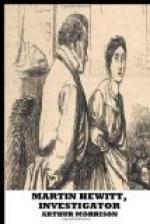The cameo, as may be remembered from the many descriptions published at the time, was said to be absolutely the finest extant. It was a sardonyx of three strata—one of those rare sardonyx cameos in which it has been possible for the artist to avail himself of three different colors of superimposed stone—the lowest for the ground and the two others for the middle and high relief of the design. In size it was, for a cameo, immense, measuring seven and a half inches by nearly six. In subject it was similar to the renowned Gonzaga Cameo—now the property of the Czar of Russia—a male and a female head with imperial insignia; but in this case supposed to represent Tiberius Claudius and Messalina. Experts considered it probably to be the work of Athenion, a famous gem-cutter of the first Christian century, whose most notable other work now extant is a smaller cameo, with a mythological subject, preserved in the Vatican.
The Stanway Cameo had been discovered in an obscure Italian village by one of those traveling agents who scour all Europe for valuable antiquities and objects of art. This man had hurried immediately to London with his prize, and sold it to Mr. Claridge of St. James Street, eminent as a dealer in such objects. Mr. Claridge, recognizing the importance and value of the article, lost no opportunity of making its existence known, and very soon the Claudius Cameo, as it was at first usually called, was as famous as any in the world. Many experts in ancient art examined it, and several large bids were made for its purchase.
In the end it was bought by the Marquis of Stanway for five thousand pounds for the purpose of presentation to the British Museum. The marquis kept the cameo at his town house for a few days, showing it to his friends, and then returned it to Mr. Claridge to be finally and carefully cleaned before passing into the national collection. Two nights after Mr. Claridge’s premises were broken into and the cameo stolen.
Such, in outline, was the generally known history of the Stanway Cameo. The circumstances of the burglary in detail were these: Mr. Claridge had himself been the last to leave the premises at about eight in the evening, at dusk, and had locked the small side door as usual. His assistant, Mr. Cutler, had left an hour and a half earlier. When Mr. Claridge left, everything was in order, and the policeman on fixed-point duty just opposite, who bade Mr. Claridge good-evening as he left, saw nothing suspicious during the rest of his term of duty, nor did his successors at the point throughout the night.
In the morning, however, Mr. Cutler, the assistant, who arrived first, soon after nine o’clock, at once perceived that something unlooked-for had happened. The door, of which he had a key, was still fastened, and had not been touched; but in the room behind the shop Mr. Claridge’s private desk had been broken open, and the contents turned out in confusion. The door leading on to the staircase




